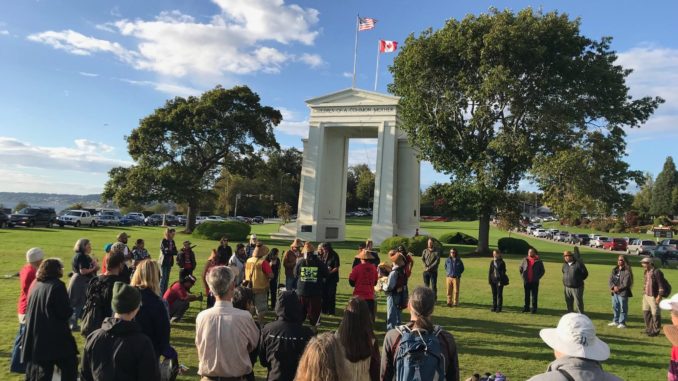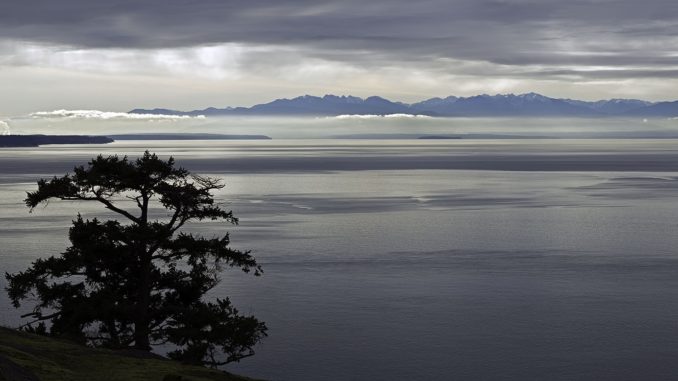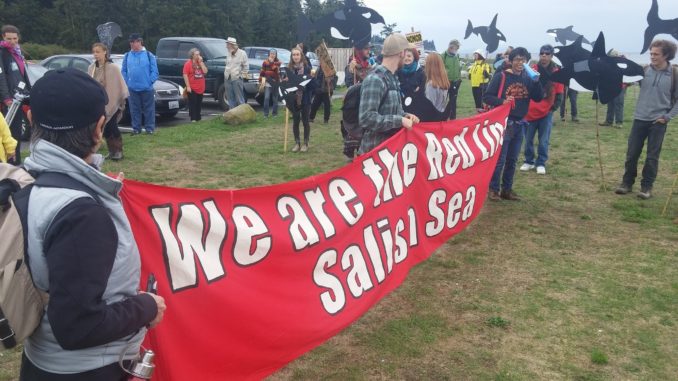
On morning of September 30, nearly nine miles south of the Washington-Canadian border, activists and indigenous people set up tents at Birch Bay State Park. After a short rally and a feast, they headed north toward Peace Arch Park, an international landmark located right on the border. Meanwhile, Canadian indigenous people and other residents walked about the same distance there from Crescent Beach, British Columbia.
This joint march featuring indigenous people from different countries was part of the Peace Arch Walk and Rally, a three-day event to defend the Salish Sea from fossil fuel projects. The Salish Sea is made up waterways that extend from Washington state to British Columbia and have come under threat from oil tankers and pipelines.
Paul Wagner, a member of the Saanich First Nations and an organizer of the event, explained the importance of challenging these projects as they could threaten to the sea’s wildlife such as orcas and salmon.
“It’s absolutely necessary to end these expansions for future of our grandchildren and for a life for the Salish Sea,” he said.
The name Salish Sea comes from Bert Webber, a marine biologist who in 1988 proposed the name in honor of the native Salish-speaking people near the water. Soon after, both countries adopted Webber’s suggestion as the official name of the sea.
The rally to defend the Salish Sea was a three-day event that focused on separate projects, mostly fossil fuels, in both countries that pose a risk to the area. One example comes from Canada—the Trans Mountain pipeline expansion, a $7.4 billion plan by energy giant Kinder Morgan that would increase tanker traffic in the Salish Sea to boost crude oil exports. If a tanker were to spill the thick and heavy bitumen oil into the sea, it would be difficult to remove and the ecosystem would suffer.
“In Kinder Morgan’s words, they have no technology to remove bitumen oil from waters,” Wagner said. “That will impact the water.”
Furthermore, the Salish Sea is home to species such as salmon that is important for First Nations communities that have fished for decades. Industrial fish farming and warmer waters have caused a decline of 60 percent among salmon in the Salish Sea since data was first collected in 1984.
“The salmon are the foundation species for all life in the Salish Sea,” he said. “All the animals depend on it. Our people depend on it.”

The locations of the three-day environmental activist gathering also represented sites of the proposals that would affect the Salish Sea. Part of the Island Gas Connector Pipeline, a proposal that would traverse the waterways and carry liquefied natural gas to a facility called Malahat LNG, would be near the Birch Bay area.
The overall project, as Sightline Institute Policy Director Eric de Place explains, would be a “permitting nightmare” as it goes through the Salish Sea and requires approval from both US and Canadian federal regulators.
“There are a lot of obstacles to figure out how to [build the Island Gas Connector Pipeline] at a reasonable cost,” he said. “The last obstacle is the LNG exports. LNG export economics are just tanking all over the place right now. Even well-financed projects in British Columbia are collapsing for lack of investors.”
Yet not all the landmarks represented risks. Peace Arch Park highlighted a symbol of peace between the U.S. and Canada that was officially established in 1921. The park is known as a center of activism that transcends borders. For example, actor and artist Paul Robeson performed there in 1952 after being denied entry into Canada.
“When Paul [Wagner] and I talked about the gathering,” said Rose Henry, a Canadian activist and another organizer of the event, “we talked about the gathering at the Peace Arch as a good location to educate Canadians and Americans at the border so they get a better understanding of the pipelines.”
Henry, a member of the Sliammon First Nations, explained the projects in her country are financed by a Canadian government that values fossil fuel projects more than investing in public services.
“I’ve been told, in Canada, there’s sixteen pipelines that are already out. It doesn’t matter which pipeline, you can pick any one of them, I can guarantee there’s going to be a lot of people that are going to be standing up and saying no,” she said.
In addition to the projects focused on by the rally, a number of speakers at the stops shared their experiences, worries, and optimism. One of these speakers was Dakota Case, an activist in Tacoma, Washington, who is demonstrating against the Tacoma LNG plant, a roughly $300 million project set to be constructed near the Tacoma Tideflats.
Case is part of the Puyallup tribe, indigenous people native to the surrounding Tacoma area that are opposed to construction of the facility.
The significant worry, among others, is the proximity of the plant to their lands. LNG facilities can potentially explode, as has happened at similar facilities across Washington. The Puyallup tribe is currently battling the facility’s permits in court with an upcoming court hearing on October 25. Meanwhile, activists such as Case are continuing to act against the project’s construction.
“The only thing natural about natural gas is where it comes from,” Case said. “Everything after is devastation. Pure devastation.”
Case felt the rally sent a “big message” in not only raising awareness of the numerous fossil fuel projects threatening the Salish Sea, but also the ability of change to stop them.
“It’s always to protect the Salish Sea here and doing it in a peaceful way. We want to demonstrate that we are a peaceful people,” he said.
On October 1, some indigenous people and activists headed toward a court hearing in Vancouver against Kinder Morgan. The case is to challenge the Trans Mountain Pipeline expansion as indigenous groups are opposed to the project’s risks to their rights and their lands.
Hilary Strang, a Vancouver native and member of the Saanich Inlet Network, a non-partisan community group, explained that the Island Gas Connector Pipeline and the Trans Mountain Pipeline Extension “would increase tanker traffic in the [Salish Sea] area by sevenfold.”
“This is an extremely industrialized area and a heavily trafficked area,” she said. “It’s also home to species at risk like the orca. It intersects all parts of fishing areas of local First Nations areas and seashell beds.”

Despite rising opposition in the province from officials and activists, the federal government led by Prime Minister Justin Trudeau supports numerous fossil fuel projects. Trudeau, in contrast to his rhetoric on preventing climate change from getting worse, is a strong proponent of these pipelines.
At a gathering of oil and gas executives earlier this year, Trudeau earned a standing ovation after saying “no country would find 173 billion barrels of oil in the ground and just leave them there.”
“The federal government is a disappointment,” Strang said before laughing. “On the one hand, we have this government that’s quite vocal about climate change, yet promoting projects that would make any sort of honoring international commitments completely impossible to reach.”
Activists are determined to continue defending the Salish Sea. Indigenous communities have organized a Nine Days of Solidarity event from October 2 to 15 against Kinder Morgan’s project. Wagner, meanwhile, highlighted a plan to make the “world’s first indigenous whale sanctuary” by creating a proclamation for all indigenous groups to sign.
In Tacoma, Case explained the success of protests in highlighting the consequences of fossil fuel facilities and raising awareness. He pointed to Kalama, Washington, where state regulators recently invalidated permits for a $1.8 billion methanol plant over its greenhouse gas emissions, as just one example.
“Before nobody in the area knew what LNG was,” he said. “But in such a short amount of time, over the past six months, we have raised so much awareness.”
Rose Henry saw the rally as something larger—a symbol of what people from different nationalities and cultures can do in protecting the cherished Salish Sea from the barrage of fossil fuel projects.
“I always tell people that we have to remember that the borders cross us,” Henry said. “We never cross the borders.”
To learn more about some of the movements in the Pacific Northwest, you can follow them online at Tacoma Direct Action, Protectors of the Salish Sea, Saanich Inlet Network, and Pull Together.
Brandon Jordan is a freelance journalist in Queens, NY. He has written for publications such as The Nation, Jacobin, In These Times, and more. You may follow him on Twitter @BrandonJ_R.
